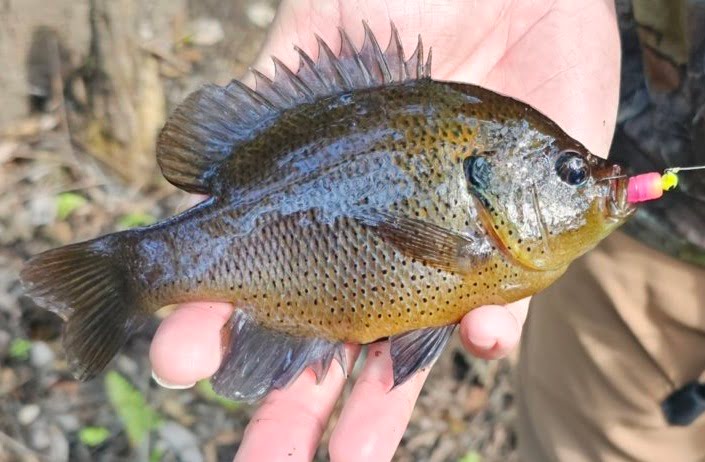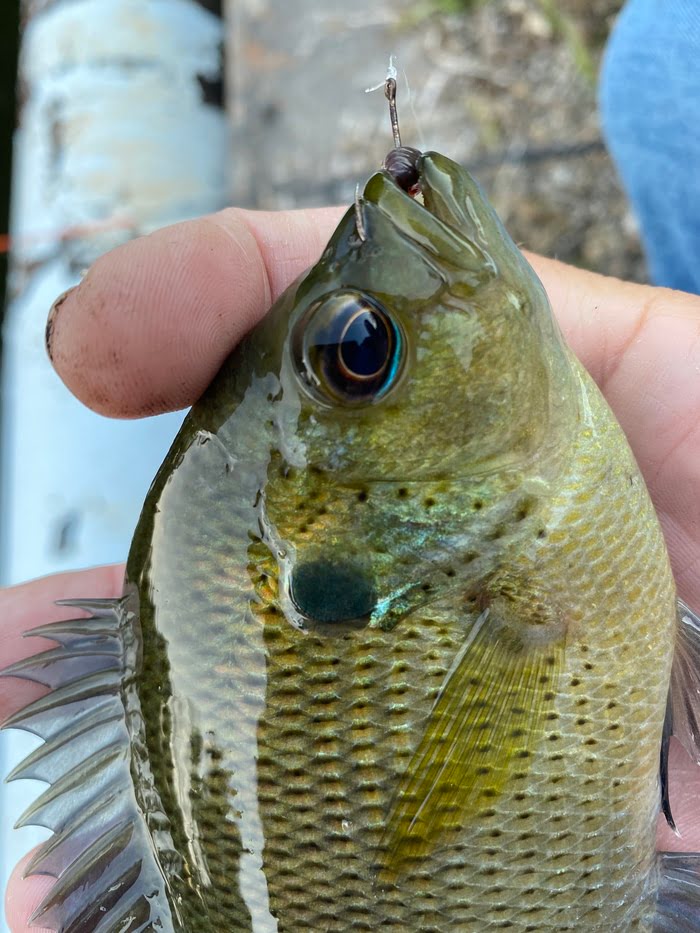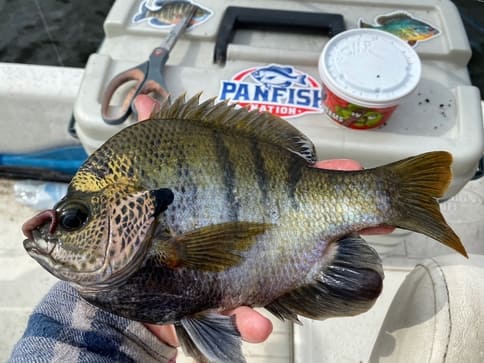When it comes to the various species of sunfish in North America, popular species like the crappie, bluegill, and shellcracker get much of the attention from anglers.
But what about the mighty stumpknocker? Also known as a spotted sunfish, this abundant and beautiful panfish is often overlooked…why is that?
In this article, I’d like to pay a little homage to the stumpknocker…I enjoy writing about them and heck, maybe you’ll learn a thing or two!
Table of Contents
About The Stumpknocker Fish
My very first memories of the stumpknocker fish were actually from my dads 55 gallon freshwater aquarium. I remember him catching some juvenile stumpknockers from one of the local lakes, and bringing them home. We’d feed them dead minnows and lunchmeat, they were a lot of fun to watch.
Ever since then, i’ve been a bit enamored with these fish. Not to mention they may have the coolest nickname of all the sunfish species “The Stumpknocker”!

And although they are rarely targeted by anglers, they are often caught incidentally when targeting other species. And boy do they pack a punch for their size!
Male stumpknockers, especially during the spawning season are known to aggressively defend their nest and will absolutely smash your lure or bait. They hit quite hard, and will run in tight circles before finally giving way.
Appearance
The Florida Fish and Wildlife Conservation Commission describes the appearance of the stumpknocker as rather ‘nondescript’. While they may be true when compared to more colorful species like a coppernose bluegill, I couldn’t disagree more!
Stumpknockers are known for their rows of small black spots that run horizontally along their body (hence the name spotted sunfish).
They have a dark black operculum, similar to a bluegill and can vary in color from dark olive, to red, green and even white in coloration.

One of the coolest features of the spotted sunfish is the blue eye shadow, or lining along the bottom of the eyes. This is particular strong during the warm spawning months, and it’s one of the most beautiful features of these unique fish.
Preferred Habitat
The name ‘stumpknocker’ should tell you all you need to know about the preferred habitat of these somewhat solitary fish. They love to hang out in submerged logs, cypress knees, roots and other aquatic vegetation.
But, I’ve found they are quite adaptable. Here in my home state of Florida I find stumpknockers in highly disturbed waterbodies, from roadside ditches to canals; they’re quite hardy.
If you are looking to specifically target stumpknockers for fishing, you’ll want to stick to shallow water. These fish are an edge species, and most likely to be along the shoreline or within casting distance.
In the spring time, look for their distinct beds in shallow water with a lone male standing guard.
Distribution
The stumpknocker is primarily found in the southeastern untied states, throughout the state of Florida, Georgia, and in south portions of the Carolinas and Alabama.
Anglers have reported catches of stumpknockers as far away as Missouri, and well into Virginia, but many of these reports are unconfirmed since stumpknockers are often confused with other species of sunfish.
Diet & Feeding Habits
Just like its cousin the bluegill, stumpknockers are insectivores, meaning they primarily feed on insect and other insect related food sources.
They’ll devour water spiders, dragonfly larvae, grass shrimp, crayfish, snails, and worms. They’re also known to eat aquatic vegetation, fish eggs and even small minnows.
They’re not very picky! Ive caught them on bread balls, hot dogs and even cat food!
Best Stumpknocker Baits and Lures
I’ve had great luck catching stumpknockers on any artificial lures with a small and subtle action (similar to a minnow or worm).
The key is that you need to downsize your lure and line to really have the best chance at hooking these fish and enjoying the tassle. (They have very small mouths!)
I prefer to use 1/16 ounce or even 1/32 ounce lures on 2-4 lb test line. Some of my favorite stumpknocker lures are the Trout Magnet, Rooster Tail, and Beetlespin.
But you also just cant beat a simple curly tail grub in your favorite color, on a 1/16 ounce jig head.
See Also: The Top 10 BEST Lures For Bluegill (W/Tips!)
If you really want to have some fun, grab your favorite 3 or 4 weight flyrod and throw on a Betts Popper and gently cast above a stumpknocker bed…wont be long before, WHAM!
What’s Considered A Trophy Stumpknocker?
Most stumpknockers average 4-6 inches in length, and weigh anywhere between 2-5 ounces.
Here in Florida, to qualify for a ‘Big Catch’ certificate, you’ll need a stumpknocker that weighs atleast 8 ounces (.5 lbs), or 7 inches in length.
Anything over 6 inches is a really nice stumpknocker, and anything over 7 inches is a real trophy!
The Florida state record is .83 lbs (13.28 ounces).
Stumpknocker Fish vs Bluegill
Stumpknockers are often confused with bluegill, partly for their similar appearance but also partly due to angler nicknames and regional terminology.
Make no mistake about it, the stumpknocker, or spotted sunfish (Lepomis punctatus) is its own unique species in the sunfish family. Just like the bluegill (Lepomis macrochirus).

Bluegill do not have the blue eye shadow under the eyes, and grow larger, up to 10 inches in length with a 5-7 inch average size. Bluegill also have faint vertical bars.

Final Thoughts
Well, I hope after reading this article you learned a thing or two about the stumpknocker fish.
I’ve grown fond of these fish over the years, and really do enjoy targeting them. And with a cool nickname like ‘Stumpknocker’, I hope other anglers appreciate these native fish as much as I do.
Thanks for reading.
Oh, and if you want to learn more about other native panfish species, check out my articles on Pumpkinseed and Green Sunfish!
If you haven’t guessed yet, I love fishing and everything about it!
To learn more about why I started Panfish Nation, visit the About page and follow along on Social Media:


Download a copy of my FREE Lure Color Selection Chart & Knot Guide!
Stay up to date with fishing reports, tackle reviews, industry news, and much more! We respect your privacy, unsubscribe at any time.
